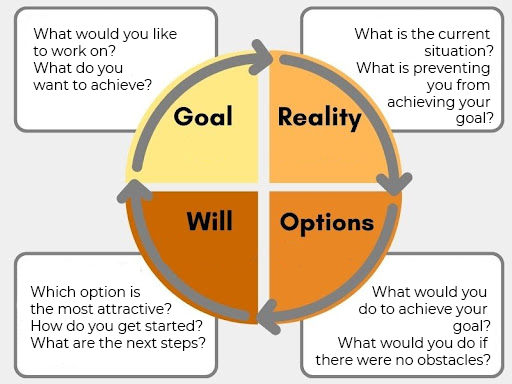
GROW model: the most successful coaching tool
The GROW model is perhaps the most successful process model ever used in coaching. Regardless of discipline, culture or structure, it has gained immense popularity around the world due to its simplicity, practicality and its goal- and results-oriented approach. In this article we will review how the GROW model was developed and what it is, and then we will go through the different phases of the process and the most important supporting questions.

What is the GROW model?
The aim of the coaching process is to move the client from the current state to the state they want to be in. To do this, it is helpful to have a structure that is easy to use in practice and makes the process transparent. The GROW model is such a framework, which provides guidance for both coach and coachee in how to:
- where the coaching process is
- what progress has been made so far
- what the remaining tasks are.
GROW is an acronym that takes its name from the combination of the initials of the English words that most characterise the stages of the process. The stages of the model guide you through the coaching process:
- G or "Goal": defining the goal
- R aka "Reality": assessing the current situation
- O means "Options": what are the options
- W is for "Way forward": what next? What are we going to do?
The GROW model is based on Socratic open questioning. By asking the right questions, the coach helps the client to be able to identify his or her goals, strengths and assets and to find a solution that will help him or her to achieve the goal.
Evolution of the GROW model
The history of coaching in the United States of America began with Timothy Gallway's book "The inner game of Tennis". Gallway recognised that what goes on in the players' heads is as important as what happens on the court. The book soon became hugely popular in other areas of life.
The coaching approach was brought to Europe with the help of John Whitmore and Alexander Graham, who, based on their own experience, further developed the GROW model. The model first appeared in John Whitmore's book "Coaching for Performance", which has been translated into 23 languages.
The model has become the defining foundation of coaching and is still used successfully around the world.
The GROW model in practice
The GROW model can be broken down into 4 stages that guide the client's development, with each stage being accompanied by a set of supporting questions. Answering these questions will help the client's personal development and facilitate important insights.
During the coaching process, the coach guides the client through the stages of the GROW model. Although the model provides clear guidelines, it should never be applied rigidly as a strict rule! The coach is free to highlight what is valuable for his client and to include other methodological elements. The point is that the coaching process should serve the client's best interests.

The phases of the GROW model
GOAL - Define the objective!
The first step is to define the purpose of the coaching process. This could be the achievement of something specific, or even the achievement of a number of small successes, or the achievement of a performance indicator. As for the duration, any goal can be chosen: short, medium or long-term.
However, it is very important to formulate the goal in the SMART objective system, so let's:
- S (Specific) - Specific, concrete
- M (Measurable)
- A (Achievable) - achievable, attainable
- R (relevant) - relevant, important
- T (Time-related) - time-bound
Poor target: "I would like to write a book about my experiences in project management"
SMART target: "In 6 months, I will write a 60,000-word book about my most instructive practical experiences in project management, which I will finish on 30 June. This will require me to write 2500 words every week."
More on the SMART objective is described in this article.
Supporting questions for the objective
- What would you like to work on?
- What exactly do you want to achieve at the end of the coaching process? (Solution, strategy, etc.)
- What are your aims on this topic?
- What would be the benefits of achieving the target?
- When do you want to reach the target?
- Who else would benefit and how?
- How would you feel if you reached your goal? What would you see, hear, feel?
- How would you know if you had achieved your goal?
- What would happen if it did not achieve its goal?
REALITY - What is the current situation?
The aim in this phase is to obtain a factual, objective and undistorted picture of the current situation, which will serve as a starting point for the subsequent implementation of the objective set at the end of the previous phase. It is at this stage that the obstacles come to light, which may be external but very often come from within: fears, beliefs, inhibitions. Identifying and overcoming them often has a huge impact in itself and almost predetermines subsequent success.
Another important task of this phase is to develop trust, common ground and honest, open communication between coach and client.
Helpful questions to explore the current situation
- What is the current situation? Where is the process now?
- What kind of problems are there? Are these problems permanent or intermittent?
- What have you done so far to achieve this?
- What could help you achieve your goal?
- What is preventing you from achieving your goal?
- What is it that seems impossible and if it were to disappear or not exist, everything would change?
- What is available to you in terms of skills and knowledge?
- How much control do you have to achieve the goal?
OPTIONS - Assessing the alternatives to the solution
The aim of this section is to gather all the alternatives that could be considered as solutions. There is more than one way to achieve most goals, and it is very useful to collect all the ideas that arise, even if they seem unrealistic. To do this, you can use the brainstorming tool, which can be used to great effect even on your own.
Even unrealistic ideas can help the client to think more flexibly and increase their creativity. And it often turns out that ideas that seem absurd at first glance can work with a little modification.
Helpful questions to explore the options
- What can you do to achieve your goal? And beyond that?
- What opportunities do you see for change?
- What are the advantages and disadvantages of the alternatives?
- What help or support do you need?
- What would others do in this situation?
- Who do you know who has achieved a similar goal and what have they done?
- What could be done differently?
- What would you do if the current obstacles did not exist?
- Imagine you have achieved your goal? What have you done to achieve it?

WAY FORWARD/WILL - Choosing and planning the way to your destination
The aim of the final phase is to select the most attractive options from those identified in the previous phase, and to plan the way forward step by step, developing a concrete action plan. It is crucial that the client is really fully committed to the implementation of the action plan. It is important to be prepared for the possibility of pitfalls and negative experiences during the active action. At this stage, the coach's main task is to keep the client motivated throughout, as it is often the loss of enthusiasm that causes the plan to go up in smoke.
Questions to help you choose the best alternative and develop an action plan
- Which option is the most attractive and why?
- How do you get started? What are the first steps?
- What are the next steps?
- When will you start?
- How would you rate your commitment on a scale of 10?
- What should be done to increase engagement?
- Who should be included in the plan?
- How can they support you?
- What can hinder the process and what can be done about it?
- How will you monitor the progress of the plan?
Summary
The GROW model is a highly versatile framework that can be used effectively not only in the field of coaching. It can be widely used as a leader, to motivate teams and subordinates, or even on its own. With the help of an experienced coach with the right mindset and other methods, it can be used to achieve outstanding results in any area of coaching.
DO YOU HAVE A QUESTION? CONTACT US!
Are you unsure about what form of support could solve your problems? Read more about our coaching services here, or contact us!

 Designabc
Designabc